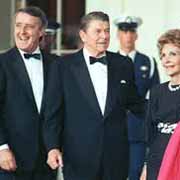CANADA HISTORY
NAFTA

Reciprocity and Free Trade: A Defining Issue in Canadian History
The issue of reciprocity and free trade has been a recurring theme in Canadian history, shaping the country’s economic policies, political landscape, and its relationship with both its southern neighbor, the United States, and its historical ties to Great Britain. From the early days of colonial North America to the 20th-century trade agreements, reciprocity and free trade have been at the heart of debates over Canadian sovereignty, economic growth, and national identity.
Early Trade in North America
Long before Canada became a state, trade was essential for the survival and prosperity of its colonies. The colonies of British North America—now modern-day Canada—engaged in trade with each other and with neighboring American colonies. This was often done despite restrictive policies imposed by European mother countries. The Navigation Acts and other trade regulations tried to limit colonial trade to within the British Empire, but trade with the American colonies, whether legal or illegal, often flourished. The desire for goods on both sides of the border led to a pragmatic approach to trade, where economic needs often superseded official restrictions.
The first formal attempt at creating a broader framework for trade between British North America and the United States came in the form of the Reciprocity Treaty of 1854. This agreement allowed for the mutual reduction of tariffs on natural resources like timber, fish, and coal between the colonies and the U.S. It facilitated economic growth for both parties and marked a step toward increased North-South trade. However, the treaty was short-lived, as protectionist sentiment in the U.S. grew during the American Civil War, leading to its cancellation in 1866. This was a significant blow to the economies of what would become Canada, as the loss of American markets posed a severe challenge for the young country in 1867, the year of its Confederation.
Confederation and the National Policy
In the wake of the cancellation of the Reciprocity Treaty, Canada's first Prime Minister, John A. Macdonald, recognized the importance of developing an economic strategy that reduced dependence on the U.S. market. He sought to foster a uniquely Canadian economy through his National Policy. Introduced in 1879, this policy was a protectionist economic framework that emphasized east-west trade across Canada, promoting the development of Canadian industries by implementing tariffs on foreign goods. The goal was to build a strong internal market and to encourage the growth of Canadian manufacturing, while also uniting the provinces economically.
Macdonald’s National Policy was a key part of his vision for a unified Canadian identity that was distinct from the United States. It sought to strengthen ties with Great Britain while also compensating for the loss of access to U.S. markets. The policy was particularly important for the development of infrastructure like the Canadian Pacific Railway, which helped integrate the western provinces with the rest of the country. For decades, the debate over protectionism versus free trade would divide Canadian politics, with Conservatives generally favoring protectionism and the Liberals advocating for more open markets.
The Free Trade Debate: Mulroney and the FTA
Fast forward to the 1980s, when the issue of free trade with the United States re-emerged as a central debate in Canadian politics. By this time, the global economic landscape had shifted, and there was growing pressure for Canada to engage in deeper economic integration with its largest trading partner, the United States. Prime Minister Brian Mulroney, who came to power in 1984, was determined to redefine Canada’s economic relationship with the U.S. Mulroney, a proponent of economic liberalization, believed that embracing free trade would boost Canada’s economy, making it more competitive globally and ensuring access to the vast American market.
In 1988, after years of negotiation, Canada and the U.S. finalized the Free Trade Agreement (FTA), which would eliminate tariffs on goods and create a more integrated North American economy. However, this agreement became the defining issue of the 1988 federal election, triggering one of the most contentious political debates in Canadian history. John Turner, leader of the Liberal Party, and Ed Broadbent, leader of the New Democratic Party (NDP), led the opposition to the FTA, arguing that it would erode Canadian sovereignty and open the door for U.S. dominance over the Canadian economy.
Turner, in particular, raised concerns that the FTA would lead to the erosion of Canadian social programs like Medicare, and that American corporations would pressure Canada to adopt U.S.-style policies, such as privatized healthcare. Additionally, Turner and his allies warned that Canada would lose control of its natural resources and monetary policy, further undermining its independence. They painted a dire picture in which the FTA would lead to an American economic takeover of Canada, diminishing its ability to protect its national interests.
Mulroney, on the other hand, defended the FTA as a necessary step to modernize the Canadian economy. He argued that the agreement would provide Canadian businesses with unprecedented access to U.S. markets, boosting exports and stimulating job creation. Mulroney dismissed the fears of his opponents, insisting that Canadian sovereignty, social programs, and cultural identity would remain intact under the agreement. He saw the FTA as an opportunity to integrate Canada more fully into the global economy while maintaining control over its key industries.
The 1988 Election and its Aftermath
The 1988 federal election was deeply divisive. It became a referendum on the FTA, with passionate arguments on both sides. Ultimately, Mulroney’s Progressive Conservatives won the election, securing a majority of seats in Parliament, although they did not win a majority of the popular vote. This revealed a highly polarized electorate, with Canadians deeply divided over the issue of free trade.
After winning the election, Mulroney moved quickly to implement the Free Trade Agreement, which took effect on January 1, 1989. However, the debate over free trade did not end there. By the early 1990s, negotiations began to expand the agreement into a broader regional trade pact that would include Mexico. This led to the creation of the North American Free Trade Agreement (NAFTA), which took effect in 1994. While Mulroney laid the groundwork for NAFTA, it was Jean Chrétien’s Liberal government that ultimately ratified the agreement, after adding two side agreements on labor and environmental protections.
The Legacy of Free Trade
The implementation of the FTA and NAFTA fundamentally reshaped Canada’s economy and its relationship with the United States. In the decades following the agreements, Canadian exports to the U.S. surged, and the economy became more closely integrated with that of its southern neighbor. Canadian industries such as energy, manufacturing, and agriculture benefited from increased market access. The automobile industry, in particular, thrived under NAFTA, as Canadian plants became key components of North American supply chains.
However, many of the concerns raised by the FTA’s opponents did not fully materialize. Medicare remained intact, and Canada retained control over its natural resources, thanks in part to protections built into the agreements. Nonetheless, critics pointed to the loss of Canadian manufacturing jobs, particularly in industries like textiles, as companies moved production to regions with lower labor costs. The agreements also sparked concerns about environmental standards, as some argued that economic growth was prioritized over environmental protection.
Politically, the FTA and NAFTA cemented the Conservative Party’s reputation as champions of free trade and economic liberalization, while the Liberal Party and NDP continued to express concerns about the implications of closer economic integration with the U.S. The 1988 election and the subsequent implementation of the FTA were pivotal moments in Canadian history, as they marked a shift toward a more open and globally integrated economy.
The debate over reciprocity and free trade has been one of the defining issues in Canadian history, influencing the country’s economic policies, political alignments, and relationship with the United States. From the cancellation of the Reciprocity Treaty in 1866 to the implementation of the Free Trade Agreement in 1989 and the expansion to NAFTA, Canada’s trade policies have always been closely tied to questions of national sovereignty, identity, and economic independence.
While the Free Trade Agreement and NAFTA brought significant economic benefits, they also raised important questions about the balance between economic growth and national control. The legacy of these agreements continues to shape Canada’s trade policies and its position in the global economy, making free trade a topic of ongoing relevance in Canadian political discourse.
Mulroney and the Progressive Conservatives vigorously championed the economic advantages of creating a North American Free Trade bloc, arguing that these benefits would far outweigh any potential negative consequences of increased trade integration. Mulroney’s message to the Canadian electorate emphasized the promise of enhanced economic growth, greater access to the vast U.S. market, and new opportunities for Canadian industries. He sought to alleviate public concerns by assuring voters that social programs, including Medicare, would remain untouched, Canadian identity would be preserved, and the country's natural resources would continue to be managed in the best interests of Canadians.
The 1988 federal election became a battleground over the Free Trade Agreement (FTA), with debates between the leaders becoming highly charged and confrontational. John Turner of the Liberal Party and Ed Broadbent of the NDP fiercely opposed the agreement, arguing that it would undermine Canadian sovereignty and erode social protections. Despite this intense opposition, Mulroney and the Conservatives emerged victorious, winning a majority of seats in Parliament. However, the election results revealed a divided nation, as the Conservatives did not win a majority of the popular vote. This split highlighted the deep national divisions over the FTA.
After the election, the FTA was passed by the Conservative government, solidifying Canada’s economic integration with the United States. The FTA's reach was later expanded to include Mexico, laying the groundwork for what would become the North American Free Trade Agreement (NAFTA). The process of ratification took several years, with the final version of NAFTA emerging in the early 1990s. When Jean Chrétien and the Liberal Party came to power in 1993, instead of canceling or renegotiating the agreement as some had expected, Chrétien added two supplemental agreements, addressing labor and environmental standards.
On November 17, 1993, the U.S. Congress ratified the agreement, passing it by 34 votes in the House of Representatives and 23 votes in the Senate. NAFTA officially came into effect on January 1, 1994. In the years that followed, many of the dire predictions made by opponents of the agreement—such as the loss of sovereignty and the dismantling of social programs—did not come to pass. While certain challenges did arise, the catastrophic scenarios that had been forecast largely failed to materialize. In hindsight, the black-and-white debate framed by Turner and Mulroney during the election evolved into a more nuanced reality, with the agreement producing more benefits than costs for Canada, but also highlighting the complexities of trade and economic integration.
Cite Article : www.canadahistory.com/sections/documents




